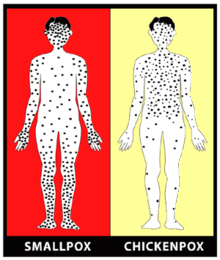Smallpox
is an infectious disease unique to humans, caused by either of two
virus variants, Variola major and Variola minor. The term "smallpox" was
first used in Europe in the 15th century to distinguish variola from
the "great pox" (syphilis). V. major produces a more serious disease and
has an overall mortality rate of 30–35%. Smallpox is believed to have
emerged in human populations about 10,000 BC.Of all those infected,
20–60%—and over 80% of infected children—died from the disease. Smallpox
was responsible for an estimated 300–500 million deaths during the 20th
century. After vaccination campaigns throughout the 19th and 20th
centuries, the WHO certified the eradication of smallpox in 1979.
 The smallpox vaccine
was the first successful vaccine to be developed. Prior to widespread
vaccination, mortality rates in individuals with smallpox were high—up
to 35% in some cases.
The smallpox vaccine
was the first successful vaccine to be developed. Prior to widespread
vaccination, mortality rates in individuals with smallpox were high—up
to 35% in some cases.
In China powdered smallpox scabs were blown up the noses of the healthy. Source material tells us on Montagu; "When Lady Mary was in the Ottoman Empire, she discovered the local practice of inoculation against smallpox called variolation.” In 1721, an epidemic of smallpox hit London and left the British Royal Family in fear.
Smallpox 2002: Silent Weapon is a fictional docudrama produced by Wall to Wall, showing how a single act of bioterrorism leads to terrifying consequences globally.

In China powdered smallpox scabs were blown up the noses of the healthy. Source material tells us on Montagu; "When Lady Mary was in the Ottoman Empire, she discovered the local practice of inoculation against smallpox called variolation.” In 1721, an epidemic of smallpox hit London and left the British Royal Family in fear.
Smallpox 2002: Silent Weapon is a fictional docudrama produced by Wall to Wall, showing how a single act of bioterrorism leads to terrifying consequences globally.



Great information. Thank you so much for sharing this article with us. Know about the best pathology lab in India.
ReplyDelete